
The family Sciomyzidae belongs to the typical flies (Brachycera) of the order Diptera. They are commonly called marsh flies, and in some cases snail-killing flies due to the food of their larvae.

Mythimna ferrago, the clay, is a moth of the family Noctuidae. The species was first described by Johan Christian Fabricius in 1787. It is distributed throughout Europe and is also found in Morocco, Algeria, Turkey, Asia Minor, Armenia, Syria, Turkestan, Israel, Lebanon, Iraq, Iran, Central Asia and the western parts of temperate North Asia. Also Tibet.

The Nematocera are a suborder of elongated flies with thin, segmented antennae and mostly aquatic larvae. This group is paraphyletic and contains all flies but species from suborder Brachycera, which includes more commonly known species such as the housefly or the common fruit fly. The equivalent clade to Nematocera is the whole Diptera, with Brachycera as a subclade. Families in Nematocera include mosquitoes, crane flies, gnats, black flies, and multiple families commonly known as midges. The Nematocera typically have fairly long, fine, finely-jointed antennae. In many species, such as most mosquitoes, the female antennae are more or less threadlike, but the males have spectacularly plumose antennae.
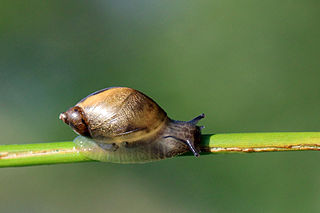
Succinea putris is a species of small air-breathing land snail in the family Succineidae, the amber snails.

Lasiommata megera, the wall or wall brown, is a butterfly in the family Nymphalidae. It is widespread in the Palearctic realm with a large variety of habitats and number of generations a year.

Coenosia attenuata, commonly called "hunter fly" or well known under the name "killer fly", is a predatory fly belonging to the family Muscidae.

Sphaeriidae is a family of small to minute freshwater bivalve molluscs in the order Sphaeriida. In the US, they are commonly known as pea clams or fingernail clams.
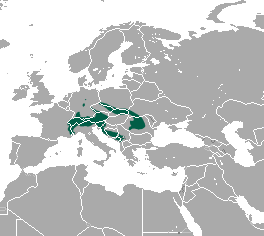
The alpine shrew is a species of mammal in the family Soricidae. It is found in the alpine meadows and coniferous forests of central and southern European mountain ranges.
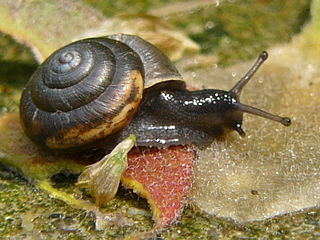
Trochulus hispidus, previously known as Trichia hispida, common name, the "hairy snail", is a species of air-breathing land snail, a terrestrial pulmonate gastropod mollusk in the family Hygromiidae, the hairy snails and their allies.
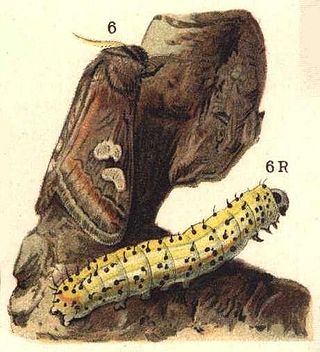
Diloba caeruleocephala, the figure of eight, is a moth of the family Noctuidae. It is found in the Palearctic.

Tachina grossa or giant tachinid fly is a very large tachinid fly.
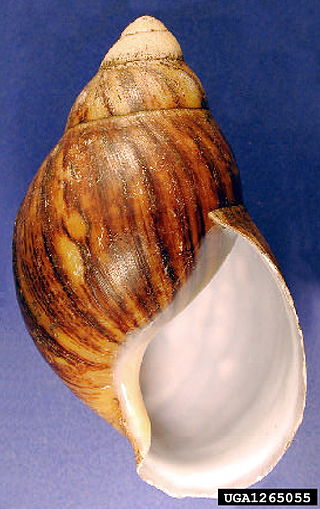
The giant West African snail or banana rasp snail is a species of air-breathing tropical land snail, a terrestrial pulmonate gastropod mollusk in the family Achatinidae. They can grow up to 20 centimetres (8 in) long, and live up to 10 years or more.

Atherix marginata, the black-legged water-snipefly, is a species of ibis flies belonging to the family Athericidae, a small family very similar to the Rhagionidae.

Pherbellia is a genus of flies in the family Sciomyzidae, the marsh flies or snail-killing flies. They occur throughout the world, except for the Subantarctic region.
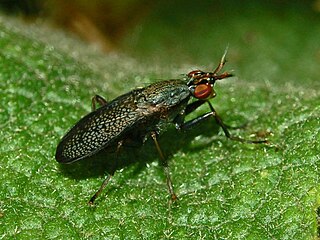
Coremacera is a genus of flies in the family Sciomyzidae, the marsh flies or snail-killing flies.
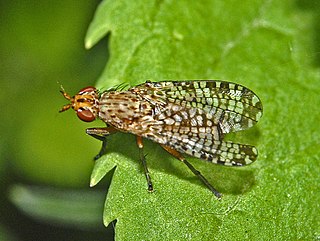
Euthycera chaerophylli is a species of fly in the family Sciomyzidae, the marsh flies or snail-killing flies.

Ablattaria laevigata is a species of burying beetle or carrion beetle belonging to the family Silphidae.

Coenosia agromyzina is a species of fly in the family Muscidae.
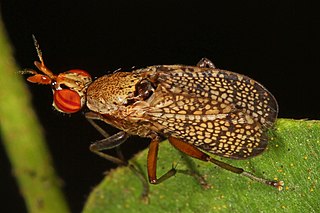
Tetanocerini is a tribe of flies in the family Sciomyzidae. There are more than 400 described species in the tribe.

Sciomyzinae is a subfamily of flies in the family Sciomyzidae.






















